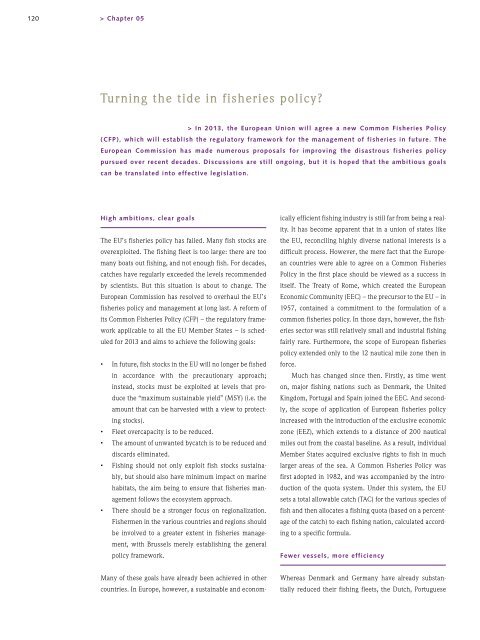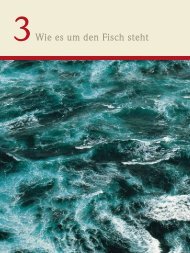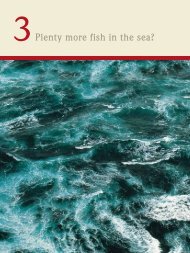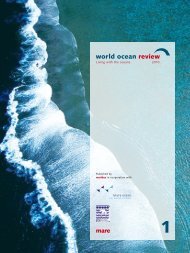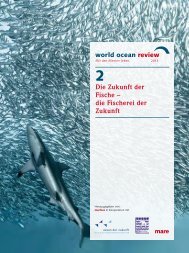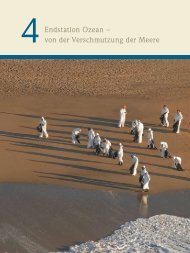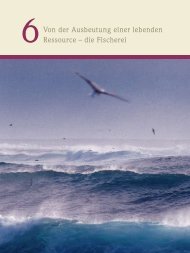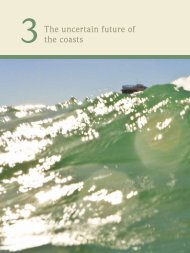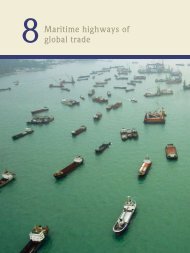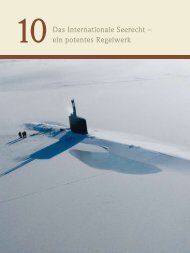Download WOR 2 PDF - World Ocean Review
Download WOR 2 PDF - World Ocean Review
Download WOR 2 PDF - World Ocean Review
You also want an ePaper? Increase the reach of your titles
YUMPU automatically turns print PDFs into web optimized ePapers that Google loves.
120> Chapter 05Turning the tide in fisheries policy?> In 2013, the European Union will agree a new Common Fisheries Policy(CFP), which will establish the regulatory framework for the management of fisheries in future. TheEuropean Commission has made numerous proposals for improving the disastrous fisheries policypursued over recent decades. Discussions are still ongoing, but it is hoped that the ambitious goalscan be translated into effective legislation.High ambitions, clear goalsThe EU’s fisheries policy has failed. Many fish stocks areoverexploited. The fishing fleet is too large: there are toomany boats out fishing, and not enough fish. For decades,catches have regularly exceeded the levels recommendedby scientists. But this situation is about to change. TheEuropean Commission has resolved to overhaul the EU’sfisheries policy and management at long last. A reform ofits Common Fisheries Policy (CFP) – the regulatory frameworkapplicable to all the EU Member States – is scheduledfor 2013 and aims to achieve the following goals:• In future, fish stocks in the EU will no longer be fishedin accordance with the precautionary approach;instead, stocks must be exploited at levels that producethe “maximum sustainable yield” (MSY) (i.e. theamount that can be harvested with a view to protectingstocks).• Fleet overcapacity is to be reduced.• The amount of unwanted bycatch is to be reduced anddiscards eliminated.• Fishing should not only exploit fish stocks sustainably,but should also have minimum impact on marinehabitats, the aim being to ensure that fisheries managementfollows the ecosystem approach.• There should be a stronger focus on regionalization.Fishermen in the various countries and regions shouldbe involved to a greater extent in fisheries management,with Brussels merely establishing the generalpolicy framework.Many of these goals have already been achieved in othercountries. In Europe, however, a sustainable and economicallyefficient fishing industry is still far from being a reality.It has become apparent that in a union of states likethe EU, reconciling highly diverse national interests is adifficult process. However, the mere fact that the Europeancountries were able to agree on a Common FisheriesPolicy in the first place should be viewed as a success initself. The Treaty of Rome, which created the EuropeanEconomic Community (EEC) – the precursor to the EU – in1957, contained a commitment to the formulation of acommon fisheries policy. In those days, however, the fisheriessector was still relatively small and industrial fishingfairly rare. Furthermore, the scope of European fisheriespolicy extended only to the 12 nautical mile zone then inforce.Much has changed since then. Firstly, as time wenton, major fishing nations such as Denmark, the UnitedKingdom, Portugal and Spain joined the EEC. And secondly,the scope of application of European fisheries policyincreased with the introduction of the exclusive economiczone (EEZ), which extends to a distance of 200 nauticalmiles out from the coastal baseline. As a result, individualMember States acquired exclusive rights to fish in muchlarger areas of the sea. A Common Fisheries Policy wasfirst adopted in 1982, and was accompanied by the introductionof the quota system. Under this system, the EUsets a total allowable catch (TAC) for the various species offish and then allocates a fishing quota (based on a percentageof the catch) to each fishing nation, calculated accordingto a specific formula.Fewer vessels, more efficiencyWhereas Denmark and Germany have already substantiallyreduced their fishing fleets, the Dutch, Portuguese


